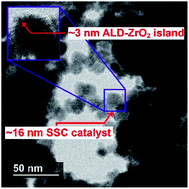ZrO2 atomic layer deposition into Sr0.5Sm0.5CoO3−δ–Ce0.9Gd0.1O2−δ solid oxide fuel cell cathodes: mechanisms of stability enhancement†
Abstract
The application of atomic layer deposition (ALD) on solid oxide fuel cell (SOFC) cathodes has previously yielded mixed results and has been seen to depend on the ALD species, catalyst chemistry, catalyst morphology, and the conditions for deposition. Characterized here is the effect of an ALD zirconia coating within an SOFC oxygen electrode: Sr0.5Sm0.5CoO3−δ infiltrated into Gd-doped ceria, Ce0.9Gd0.1O2−δ, scaffolds (SSC–GDC). Island-like ALD-ZrO2 coatings with approximately monolayer coverage initially yield a higher electrode polarization resistance, RP, but thereafter the coated electrodes show lower RP and slower degradation. For example, after ∼1000 hour accelerated ageing tests carried out at 750 °C, SSC–GDC coated with ∼0.3 nm of ALD-ZrO2 showed an RP increase of 18% compared to 30% for uncoated SSC–GDC. Strontium surface segregation was not found to be a significant degradation factor. At 750 °C, a reaction between the Zr-overlayer and the SSC was observed, producing SrZrO3, Co3O4, and SmCoO3. The low RP values achieved suggest that the reactant products were thin enough to be discontinuous and thus not hinder the oxygen surface exchange process, and yet they acted as a barrier to SSC particle coarsening.



 Please wait while we load your content...
Please wait while we load your content...
